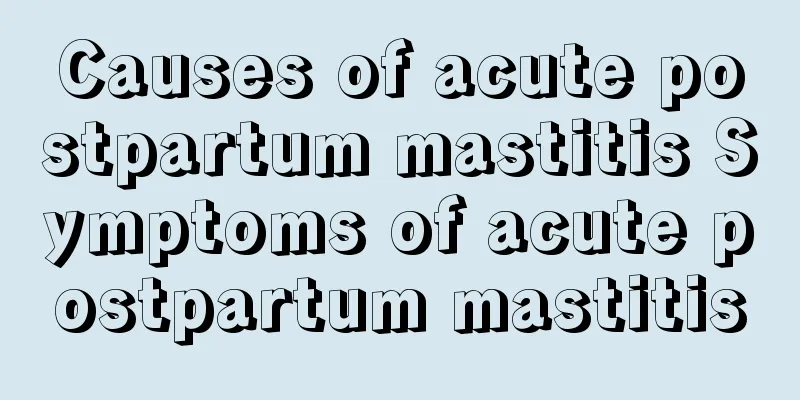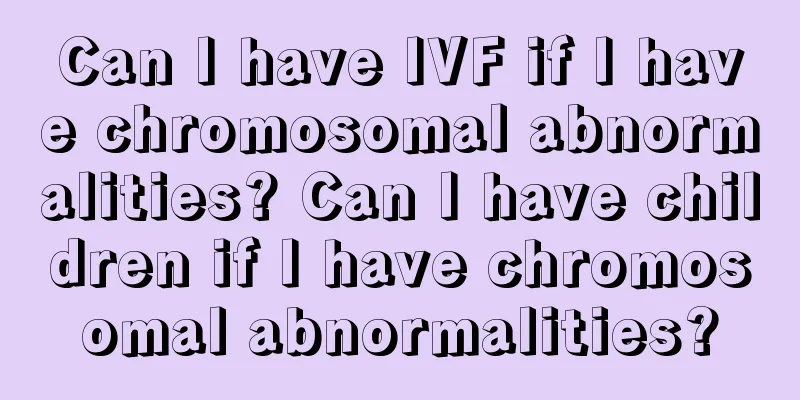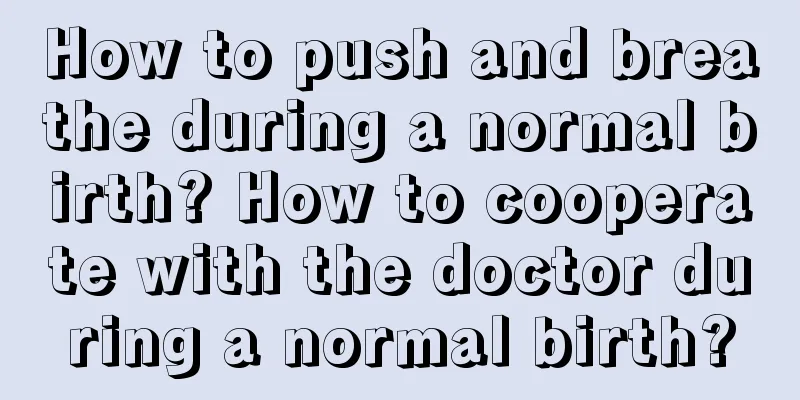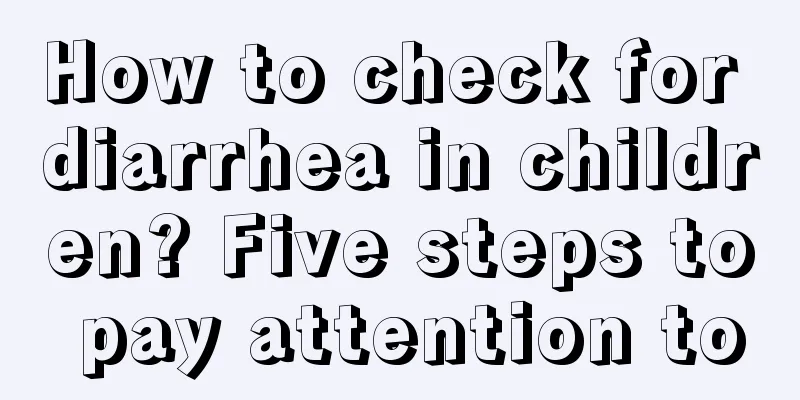Causes of acute postpartum mastitis Symptoms of acute postpartum mastitis

|
Many mothers will get mastitis after childbirth for various reasons. Today, let’s talk about what to do with acute mastitis. Acute mastitis is not terrible, and good treatment is the hard truth. Causes of acute postpartum mastitisAcute mastitis is an acute suppurative infection of the breast caused by pathogenic bacteria invading the breast and growing and multiplying in it. This disease is more common in women who are mothers for the first time and often occurs 3-4 weeks after delivery. There are two main causes of acute mastitis. On the one hand, milk stasis is likely to lead to the growth and reproduction of invading bacteria. The main causes of milk stasis are poor nipple development (too small or inverted), which hinders breastfeeding. Excessive milk secretion or insufficient breastfeeding of the baby, incorrect breastfeeding posture, and blocked mammary ducts can also cause milk stasis. On the other hand, bacteria may also often invade through damaged or cracked nipples, and invasion along the lymphatic vessels is the main route of infection. When a baby sleeps with the nipple in his mouth or when a baby with stomatitis sucks milk, bacteria can directly invade the mammary ducts and ascend to the glandular lobules to cause infection. Symptoms of acute postpartum mastitisAcute mastitis mostly occurs in first-time mothers who lack breastfeeding experience. The first month after delivery is the peak period for acute mastitis; and after 6 months, babies begin to grow teeth, and the nipples are also easily damaged during this stage, so you should be careful to prevent it; and you should be more vigilant about the occurrence of acute mastitis during the weaning period. If you have acute mastitis, you will feel breast pain at first, with local lumps and distension. As the disease progresses, you may also feel cold, shiver, or have a sudden rise in body temperature, sometimes to over 39 degrees. Generally, only one breast will be inflamed. The affected breast will be so painful that you cannot press it. The local skin will be hot, red, swollen, and have lumps. The lymph nodes in the armpit on the same side will be swollen and painful when pressed. If you go to the hospital for a routine blood test, it will show a significant increase in the number of white blood cells. However, the symptoms of acute mastitis vary from person to person. If a mother who is taking antibiotics has local inflammation, the symptoms may be masked. If not treated in time, the diseased breast is likely to become festered, and even the internal tissues may be damaged. In severe cases, breast atrophy may occur. How to prevent and treat acute postpartum mastitis:1. For acute postpartum mastitis caused by non-bacterial infection, inflammation can be improved by improving the breastfeeding posture, adequate breastfeeding, avoiding compression of the mammary ducts, and frequent local massage. Friendly reminder from breast surgery experts: Only professional and regular massage can achieve good results. 2. If you have acute postpartum mastitis caused by bacterial infection, you can still breastfeed your baby (except for acute mastitis caused by drug-resistant Staphylococcus aureus), and the mother can take medication as appropriate under the guidance of a doctor. 3. For postpartum acute mastitis that has already become purulent, our hospital mainly promotes the unique minimally invasive treatment of "puncture and extraction of pus without milk return", which is an advanced treatment method that uses puncture of the abscess cavity to allow normal breastfeeding after healing. It not only shortens the course of the disease, but also meets the requirements of breastfeeding. Should I stop breastfeeding if I have mastitis?In case of acute mastitis, breastfeeding should not be stopped, because stopping breastfeeding will not only affect infant feeding, but also increase the chance of milk stasis. Therefore, when you feel breast pain, swelling or even local skin redness, you should not stop breastfeeding, but also feed your child frequently to let the child suck out the milk in the breast as much as possible. When the breast is locally suppurated, breastfeeding on the affected breast should be stopped, and the milk should be drained with the usual milking technique or a breast pump to promote smooth milk discharge. At the same time, the child can still eat breast milk from the other healthy breast. Only when the infection is severe or the abscess is incised and drained, or when mastitis occurs, should breastfeeding be completely stopped, and active measures to stop milking should be taken according to the doctor's advice. |
<<: How to relieve toothache during breastfeeding?
>>: Can alcohol wipes be used to wipe the face? Can alcohol wipes be used to wipe wounds?
Recommend
How to treat bronchitis caused by cold in children
Young children are very susceptible to colds, esp...
Why does the stool smell bad if the baby is breastfed? Protein indigestion
Sometimes babies who drink only breast milk will ...
How long after IVF egg retrieval can I have sex? How to avoid ascites after IVF egg retrieval?
IVF egg retrieval causes some trauma to the femal...
How to prevent amblyopia in infants and young children? Three methods to prevent it reasonably
Nowadays, many children are myopic, and the age o...
Why are the baby's leg lines asymmetrical? What are the growth and development standards for infants and young children?
Sometimes, carefully observing the baby's leg...
Nice and non-tacky girl names Nice and non-tacky girl names
A person's name is very important and will ac...
Why do women have morning sickness and how to reduce morning sickness
The biggest worry for contemporary women is proba...
How to regulate your body during pregnancy preparation? How to increase the chance of pregnancy during pregnancy preparation
Now more and more people are beginning to advocat...
Why is Shuke toothpaste expensive? Which Shuke toothpaste is the best?
The actual user experience of Shuke toothpaste is...
How long does it take for a scented candle to burn for the first time? What kind of material is good for scented candles?
Aromatherapy candles are a product that many peop...
Is the Thai TwinLotus Chinese Herbal Toothpaste good to use? Review
Toothpaste is a necessity in our daily life. We a...
Which country's brand is Sensodyne toothpaste from? How to distinguish the authenticity of Sensodyne toothpaste?
The brand of toothpaste, Sensodyne, is also commo...
Can I eat watermelon during the dog days of summer? Is it good to eat watermelon during the dog days of summer?
Many women who have just given birth will spend t...
What are the key points of raising children aged 0-6?
Parents are the first teachers of their children....
How to push and breathe during a normal birth? How to cooperate with the doctor during a normal birth?
Natural childbirth is not as scary as we think. I...









